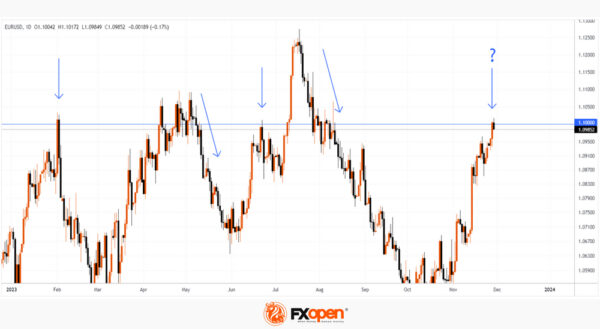Before yesterday’s trading session, the last time 1 euro was 1.1 USD was in the first half of August.
The growth of the rate was facilitated by the weakening of the dollar, which occurred against the background of the words of Christopher Waller, a member of the Fed Board of Governors, who is known for his hawkish policies. But he has already softened his position.
“I am increasingly confident that policy is currently well positioned to slow the economy and get inflation back to 2 percent,” he said yesterday, however, adding that if the decline in inflation continues “for a few more months… three months, four months, five months… we can start reducing the discount rate just because inflation is lower.”
The expected rate cut could mark the beginning of a new period of looser monetary policy. Therefore, financial markets reacted by increasing the prices of currencies relative to the dollar — in particular, the euro reached a psychological level.
The chart shows that in 2023 the price of EUR/USD interacted with it several times, which caused, among other things, trend reversals. As the arrows show:
→ a bearish reversal took place in February;
→ in May the price entered consolidation, but exited it in a downward direction;
→ the level worked as a resistance in June.
The sharp rise in July above the 1.100 level turned into an equally rapid fall.
Taking into account the above facts, there is reason to assume a scenario in which the level of 1.100 will once again in 2023 resist the appreciation of the euro. Moreover, this is already noticeable, since on Wednesday the price exceeded Tuesday’s high and turned down (a sign of a false bullish breakout).
This article represents the opinion of the Companies operating under the FXOpen brand only. It is not to be construed as an offer, solicitation, or recommendation with respect to products and services provided by the Companies operating under the FXOpen brand, nor is it to be considered financial advice.













